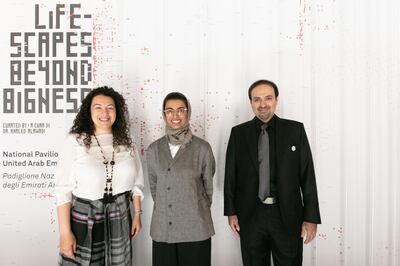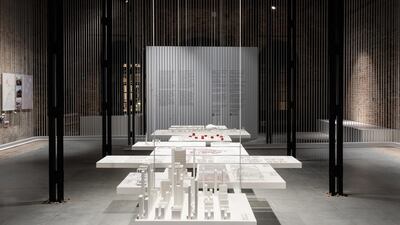In the old fort of the Arsenal of Venice, the pavilion representing the United Arab Emirates at the 2018 Venice Architecture Biennale is bordered by those of Saudi Arabia and Mexico.
Lifescapes Beyond Bigness, curated by the Emirati architect and urban planner Dr Khaled Alawadi, is enclosed by a barrier of high white steel bars – tall, yet thin enough to be transparent, if not almost invisible. Inside is a spine of table-level models of high-rise and low-rise construction. On the walls, along with more charts based on the research of Alawadi’s team, are photographs and testimony on everyday life from ordinary inhabitants of small places in the shadow of bigness in Dubai and Abu Dhabi.
“It’s sleek, we paid a lot of attention to details,” says Alawadi, “People, once they see it, might build a kind of mental image of a structure that they have to physically cross in order to discover the exhibition’s contents. It’s a metaphor for the hidden sites of the UAE’s urbanism. You have to change your typical route, change your direction, in order to uncover those interesting lifescapes beyond the contemporary city of bigness.”
Putting a human face on architecture and urbanism
Part of Alawadi’s project involved research into the evolving relation of high-rise to low-rise construction, to the proportion of green space in cities, and to the networks of streets and alleys in which everyday life is lived in the shadows of structures that form high-profile city skylines.
“In any city in the world, you can see this hierarchy – from the high-rises, to the mid-rises, to the low-rises. To be honest, it’s not showing anything new,” says Alawadi. “But it’s showing this kind of juxtaposition or contrasting image between bigness and the human scale which are very very close to each other.”
Alawadi’s research proves that point, with a twist that we might call upstairs-downstairs urbanism. Yet there is a new element here – photographs of individuals and families, on the ground, so to speak, in everyday situations that involve working, relaxing, and even praying.
“We must have at least 10,000 photographs for this project – and at least 4,000 [I took] by myself,” he said, noting that his team included 12 students who made site visits three times a week. “The students were mostly the soldiers on-site,” he explains, sitting at the shaded patio of the Sale d’Armi building that houses the pavilion. Electric carts carrying early visitors to the Biennale race up and down gravel lanes.
One way of describing Alawadi’s project is the mission to put a human face on architecture and urbanism. That turn of phrase is also a conceptual pivot in the study of urban design, says Kevin Mitchell, Professor of Architecture and Interim Provost at the American University of Sharjah, who has known Alawadi since he was a graduate student.
“If one looks at the kind of conversation that goes on about the urban environment, the built environment, in the UAE, it mainly focuses on individual works of architecture,” says Mitchell, a 20-year resident of the Emirates. “This redirects the conversation to focus on spaces in between, and on what it means to inhabit the built environment.”
“I think it’s important to understand how people perceive and use space. If one looks at space as an architect, it’s usually without people and without their lived experience,” Mitchell notes, pointing to the photographs on view.
“This provides the opportunity to think about what that lived experience is, and what it means to individuals,” he says. “Often architects think about experience and design around it. This is looking at lived experience from an analytical point of view, and how we can use those stories and narratives, and use them to better the built environment.”
'We never see the skyline of neighbourhoods'
Another perspective on the pavilion's challenge to urbanism's conventional wisdom came from Noura Al Kaabi, the UAE's Minister of Culture and Knowledge Development. The minister was among the visitors to Alawadi's project at its crowded opening. It was her second visit, after a quiet tour of the pavilion with Alawadi the day before.
“Most of the time, when you hear the UAE, what sticks in your head is a certain building, or a certain element of how our skyline looks. But we never see the skyline of neighbourhoods,” she says.
“It’s fascinating, because the urban planners or the architects will say, ‘this will be the common space’. But surprisingly, you see a common space over there, which is the corner where everyone is praying. Such common spaces are always influenced by the people, and how the people will utilise such space. Building will play a role, for sure, but there will be always that human element of how to utilise that common space together.”

The photographs by Alawadi and his team focus on that human element. One scene among many shows an informal outdoor mosque on a street corner in Abu Dhabi, where prayers are led by an imam from Bangladesh.
The architectural models, delicate creations of city-scapes, give a broader evocation of urban evolution, with high-rise and low-rise in contrast, and in comparison over time.
A chart of green space offers another perspective on the human. In one low-rise neighbourhood with gardens throughout, which on a chart look like calligraphic improvisations, no two green spaces have the same shape – an instant evocation of the notion of human scale.
_________________
Read more:
Meet the Saudi architects making their debut at the Venice architecture biennale
New Sharjah programme on a mission to make our cities more humane
A new project traces the history of the UAE's urban design
_________________
“The models are an effective way to communicate an idea,” explains Dr Martin Scoppa, who is an architect on Alawadi’s team. “Immediately you can see changes in scale; you can see the shape of things. The architectural drawings are harder to relate to if you’re not part of the profession.”
At the opening of the pavilion, Alawadi took in a deep breath and reflected on the lessons learnt during this year’s worth of work. “Bigness is always there. Suburban growth is unstoppable,” he concluded.
It’s no surprise that human was then the keyword once again: “We have to put human focus at the core of design. Cities accommodate different systems – streets, infrastructure, buildings, transit – but we have to think about the human scale first. Then we have to accommodate other systems around that.”
A future line of inquiry in the UAE? “What is your most important capital?,” asks the cultural minister as she surveys the activity in the pavilion. “If it’s the people, that discussion’s going to continue.”
Lifescapes Beyond Bigness will run at the National Pavilion UAE at the Venice Architecture Biennale until November 25

